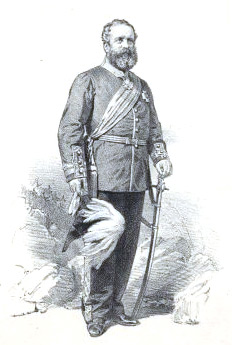General Sir Trevor Chute KCB
A Distinguished Officer of the Seventieth
 |
| General Sir Trevor Chute, KCB Picture: Illustrated London News |
General Sir Trevor Chute, KCB had a long and distinguished career in the Army. He was born in 1816 and his first appointment was as ensign in the Ceylon Rifle Regiment. Transferring to the Seventieth in 1839, he was promoted Captain in the same year.
After service in the West Indies and Canada the Regiment returned to England in 1843, where they remained for two years. Then followed four monotonous years of garrison duty in Ireland during which time Chute was promoted to major.
The Seventieth embarked at Cork for India early in 1849 in six ships of the Honourable East India Company’s fleet. Soon after arrival at Caloutte the Regiment suffered its first losses from disease, principally cholera that was to take such a heavy toll of all ranks. 79 officers and men died at Dum Dum and another 79 at Caloutte. Consequently it was with relief orders to proceed to Cawnpore were welcomed.
In December 1850, the Seventieth, under Lieutenant Colonel Chute, moved by river from Calcutta to Allahabad and thence by march route to Cawnpore. They had not however shaken off the hold of the dread disease, and it is sad to relate the during their three years stay at Cawnpore the Regiment lost from cholera two officers, 344 men, 37 women and 99 children. Throughout these afflictions and those that followed in Ferozepore two years later, when another officer and 90 men died from cholera, the morale of the Regiment remained unbroken. On no less than three occasions tribute was paid to their orderly and soldier-like conduct, and this was undoubtedly due to the leadership and encouraging example of their Senior Officers.
The next station of the Seventieth was Peshawar where they arrived on New Year’s Day. 1857. It was not long before the Indian Mutiny broke out that Colonel Galloway of the Seventieth was appointed Brigadier in command of the station, and command of the Regiment devolved upon Bt. Colonel Chute.
In May, a small column of cavalry, a troop of artillery and some 170 all ranks of the Seventieth under Colonel Chute were despatched against the mutineers of the 55th Native Infantry in the fort of the Hoti Mardam. This was the first and probably the only time in Regimental History the infantry were mounted on elephants, and one can imagine the ribald remarks passed from one howdah top another as the column lurched off into the hills. A short but bloody battle ensues resulting in the complete defeat of the mutineers. The Seventieth brought back 120 of them to Peshawar, of whom 40 were later executed by being blown to pieces by guns.
A few weeks later Colonel Chute’s column, now reinforced, marched on one of the frontier posts at Abazai and succeeded in disarming a detachment of the 64th Native Infantry without bloodshed. In August 1857, having been appointed to the command of a brigade, Chute succeeded in annihilating the 51st Native Infantry which had attacked Peshawar cantonments. For the next three years Brigadier General Chute served in Lucknow and Bengal.
He appears to have reverted to his substantive rank in February 1861, for he embarked in command of the Seventieth Regiment for New Zealand. This was his last period of Regimental duty. He served as a Brigadier General in Australia from 1863 to August 1865 when he returned to New Zealand as a Major General to assume the direction of operations in the Maori Wars. He returned to Australia in 1867, the year in which he was appointed KCB, for a further period of three years and in May 1873, now a Lieutenant General, he became Colonel of the 22nd Foot (The Cheshire Regiment).
Finally promoted to General in October 1877, this fine old Officer was still serving in 1881, fifty years after being commissioned.
He married Ellen, the eldest daughter of Samuel Browning of Auckland. He died suddenly on 12th March 1886 at Binfield, near Reading.
Select Bibliography
T. W. Gudgeon, The Defenders of New Zealand (Auckland, 1887); J. M. Templeton, The Consolidation of the British Empire (Melb, 1901); H. W. Pearse, A History of the East Surrey Regiment, vol 1 (Lond, 1916); J. Cowan, History of the New Zealand Wars, vol 2 (Wellington, 1922); A. J. Harrop, England and the Maori Wars (Lond, 1937); Argus (Melbourne), 22 Aug 1870, 16 Mar 1886; Times (London), 15 Mar 1886; Illustrated London News, 1 May 1886.
Related
